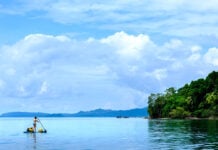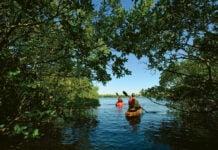Banff National Park is Canada’s most-visited national park for good reason. Canadians have been drawn here since the 1880s, attracted to the park’s glacial lakes, rushing rivers, snow-capped mountains and hot springs.
Known worldwide for its skiing and snowboarding, you can also ice climb, fat bike, skate, snowshoe and cross-country ski here during the winter months.
But we’d argue that summertime is when the region truly comes alive, with even more Banff activities on offer. Campgrounds reopen, making overnight stays a bit more affordable and a lot closer to nature. With the avalanche risk gone, hiking and cycling trails reopen for the season. And, most importantly, lakes start to melt, revealing the turquoise waters beneath and providing some of the most scenic canoeing and kayaking in the country.
If you’re considering taking a Banff vacation, here’s our ultimate Banff travel adventure guide.
Things to do in Banff in summer
Banff hikes
There are dozens of frontcountry and backcountry hikes to tackle in Banff National Park, with a handful of tour companies offering guided excursions, including heli-hikes.
If you prefer to go it alone, you’ll have no problem finding a trail that fits your afternoon, day or weekend plans—whether that means exploring high-alpine meadows or crossing the ridgelines of some of the Rockies’ most awe-inspiring mountains. This is hands-down one of our favorite things to do in Banff.
Parks Canada has a comprehensive guide to walks within the park, organized according to ability level. But if you’re having a hard time narrowing down hikes in Banff worth doing, here are three of the most popular trails for first-time visitors to the area.
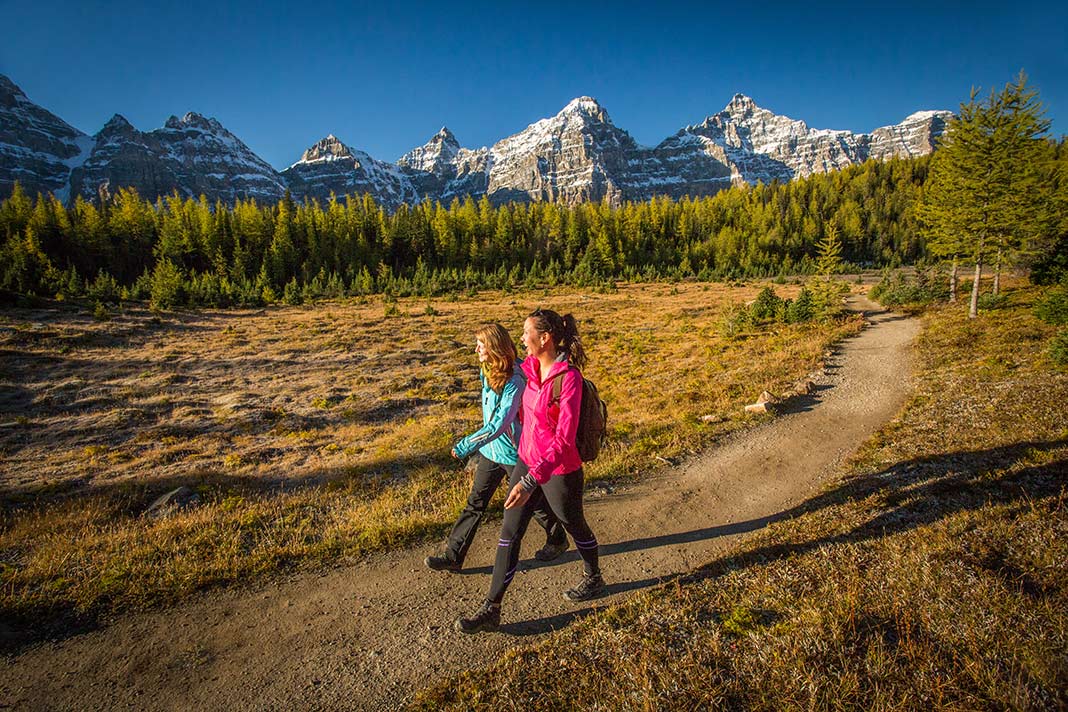
Lake Agnes Trail & Teahouse
Is the Lake Agnes trail one of Banff’s most popular hikes because of the lure of scones and tea at its end? You only need to see the happy hikers at the top to know the answer to this question. Starting from Lake Louise, this trail winds for 3.4 km uphill past the lake to the European-style teahouse on the edges of a tarn.
The track is easy and wide, but still takes a moderate level of fitness, given its 385 meters of elevation gain. If you really want to earn your morning tea, take the additional 1.6-km trail behind the lake and up to the top of the Big Beehive for epic panoramic views of Lake Louise and the Chateau Fairmont below. The full journey takes between three and five hours.
Johnston Canyon & The Ink Pots
A trail suitable for all skill levels, you can make this one as long or as short as you want. You’ll reach the first set of falls within half an hour, and if you follow the wide path deeper into Johnston Canyon, you’ll arrive at a 30-meter-high waterfall about 30 minutes later. Beyond the falls, there’s an alpine meadow where water bubbles into shallow pools known as the Ink Pots.
For the lower falls, budget an hour round-trip, two hours for the upper falls, and a full four hours to reach the ink pots. The trailhead can be found 25 km from Banff and 33 km from Lake Louise along the Bow Valley Parkway.
Larch Valley
In the autumn, the larch trees of Banff turn a brilliant shade of gold before shedding their needles. Large stands of them can be found along the Larch Valley trail, which is the park’s most popular trail come September and October. Located just beyond Moraine Lake Lodge, you’ll need four hours for this 8.6-km round-trip journey, which has an elevation gain of 535 meters.
Since grizzlies are frequently spotted in this area, hikers should carry bear spray, travel in groups, and make plenty of noise along the way.
Rock climbing & via ferrata
Offering some of the best rock climbing in Canada, Banff has walls suitable for all skill levels of climbers, from beginner faces to multi-pitch routes, and steep sport climbing spots. Never climbed before? Alpine Air Adventures and Yamnuska Mountain Adventures both offer guided excursions.
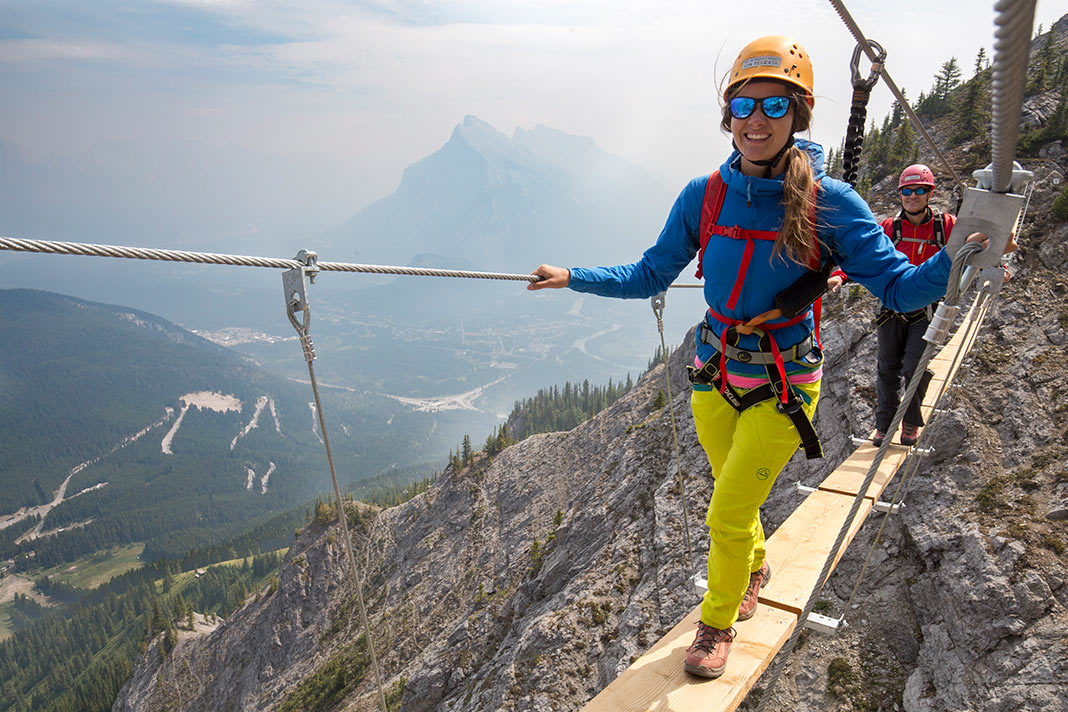
However, you don’t need impressive upper body strength to climb mountains in Banff. Mt. Norquay’s Via Ferrata route is a series of rungs, bridges and ladders that aid climbers in scaling the sides of mountains. There are four routes, ranging in length from 2.5 to six hours. Each experience is guided, with the price starting at $175 CAD.
Banff biking
Banff bike trails
Much like hiking trails, there’s no shortage of mountain biking, road biking and fat biking trails and routes available in Banff National Park. There’s more than 360 km of trails, which are accessible roughly from May until October.
Note that e-bikes aren’t allowed on the trails (with a few exceptions) and if you’re looking for a true downhill mountain biking experience, you’d be better placed to visit nearby Yoho National Park, where there are designated trails for freeriding.
You can visit Parks Canada for a full list of trails, organized by difficulty, but here are just a few routes worth tackling.
Tunnel Mountain Campground Loop
Ideal for beginners and families, this 6.5-km gravel circuit starts at the Tunnel Mountain Campground with plenty of places to stop, rest and gawk at the elk, deer and even coyotes along the way.
Canmore to Banff bike trail
The relatively new and relatively flat Banff Legacy Trail is a 29-km paved path connecting the town of Banff with the town of Canmore just outside the national park. It’s rideable from April to October, with trailheads at Valleyview, Cascade Ponds, Vermilion Lakes and Fireside day-use areas, as well as at the east end of Banff Ave.
Lake Minnewanka
For those looking for more of a challenge, this 29.4-km one-way trail runs from the Lake Minnewanka day-use area to the Warden’s Cabin and beyond. You’ll need to be fit to handle this trail, which takes you along exposed sidehill trails that climb steadily into remote mountain areas.
Banff bike shops
The Tune Shop
A locally owned retailer, The Tune Shop carries Cube, Evo, Thule, Shimano, Yakima and Bern bikes, parts and accessories, as well as e-bikes. It’s located at 16 Eagle Crescent in Banff and open Tuesday through Saturday from 11 a.m. to 7 p.m.
Banff Soul Ski + Bike
Located at 203A Bear Street, Banff Soul Ski + Bike performs bike servicing and repairs by appointment, including professional shock and fork servicing. A range of bike accessories, parts and apparel is also available.

Bike rentals in Banff
Banff Cycle
Offering e-bikes, hybrid and road bikes—as well as cycling tours—this rental shop is located within Banff Soul Ski + Bike at 203A Bear Street. Bike rentals start at $49.95 CAD per day, with weekly discounted rates available. It’s open from 9 a.m. to 5 p.m. daily, and bikes may be reserved online in advance of pick-up.
Bactrax
Name your style of bike and Bactrax has got it. Whether you’re looking for a cruiser, touring bike, BMX or even a bicycle built for two, you’ll find it here. Adult bike rentals start at $25 CAD for a half-day and $35 CAD for a full day. Its storefront, at 225 Bear Street, is open daily from 8 a.m. to 8 p.m.
Ultimate Sports
Along with stocking bike accessories, this outfitter has bicycles for rent, including Scott bikes, full suspension trail bikes, and e-bikes with motor assist for longer journeys. Bikes can be rented per hour (starting at $13 CAD) or by the day (starting at $45 CAD). Ultimate Sports can be found on Banff’s main drag at 206 Banff Ave.
SkiBig3 Adventure Hub
Need an e-bike rental? SkiBig3’s Adventure Hub shop has got you sorted with its extensive fleet. It can be found at 114 Banff Ave and bikes may be reserved online in advance.
Wilson Mountain Sports
For bicycle rentals in the hamlet of Lake Louise, there’s Wilson Mountain Sports. Rentals—which start at $20 CAD per hour or $49 CAD for a day—include hybrid, front suspension and e-bikes. Wilson Mountain Sports is open daily from 8 a.m. to 6 p.m. and can be found at 201 Village Road.
Banff Adventures
In 2021, Banff Adventures (at 211 Bear Street) added Marin hardtail mountain bikes ($32 to $45 CAD) and Urban electric bikes ($45 to $65 CAD) to its offerings. All bicycles are available on a first-come, first-serve basis for half-day and full-day rentals. If you want to extend the adventure, they can also be combined with canoe rentals, chairlift tickets, and gondola rides to create a package.
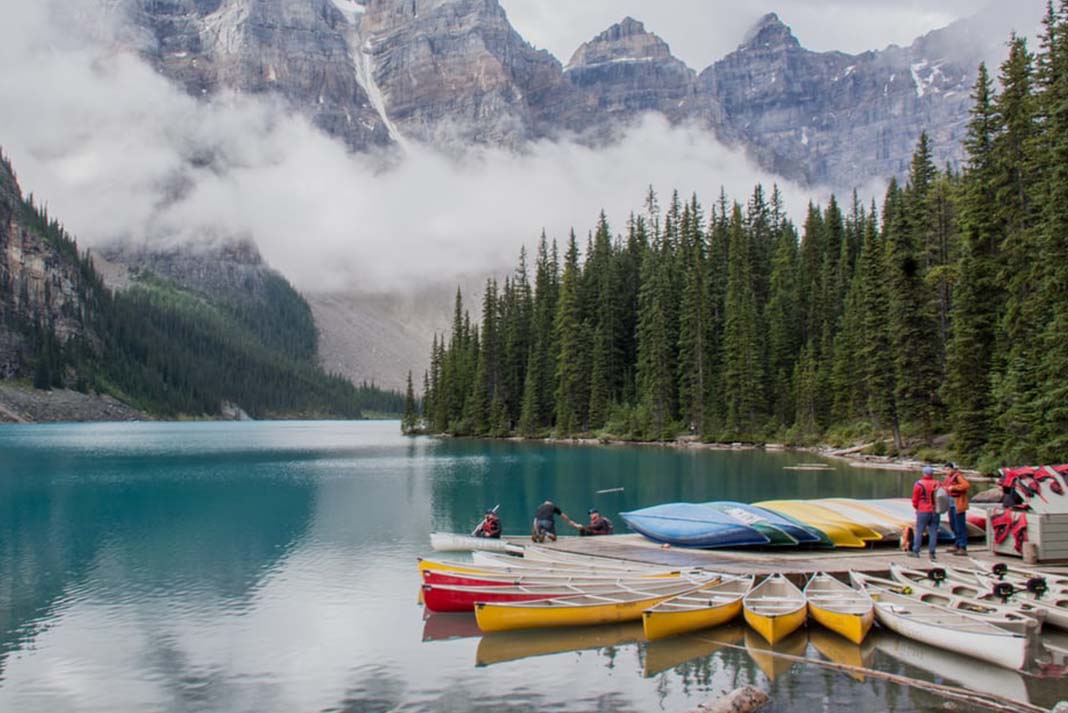
Banff paddling
From exploring the fast-flowing Bow River to turquoise alpine lakes, Banff National Park is considered one of the most iconic paddling destinations in Canada.
Check out our Guide To Paddling In Banff for more information on the best locations, tours, and kayak, canoe and SUP rentals.
Banff rafting
While there is no whitewater rafting available directly within Banff National Park, you don’t have to drive far to access the adrenaline-pumping class II, III and IV rapids of the Bow River’s Horseshoe Canyon, the Kananaskis River or the Kicking Horse River.
If you’re ready to get wet—or even just to go for a scenic flatwater float—read our Guide To Rafting In Banff to learn how.
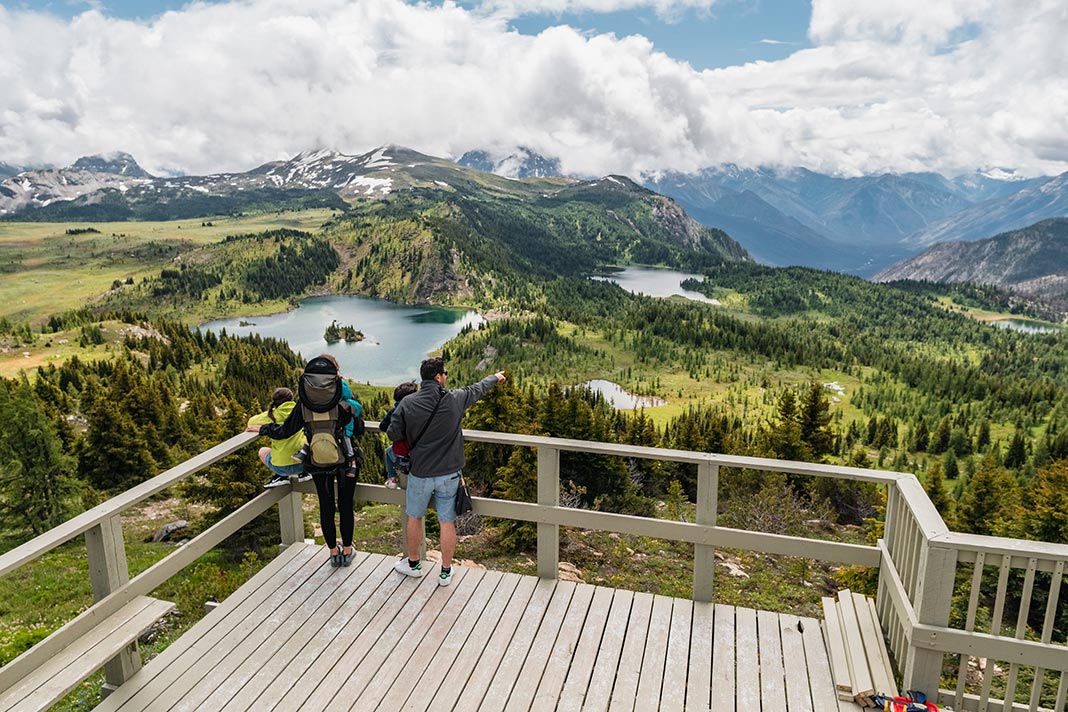
Places to stay in Banff
Banff camping
Finding accommodation in Banff can be challenging, with hotels charging a premium for their prime location.
For those wondering where to stay in Banff on a budget, camping might be the answer. Parks Canada manages and operates 14 frontcountry campgrounds in Banff, with a total of nearly 2,500 sites available for tents, camper vans and motorhomes. That’s not even making mention of the roughly 50 backcountry sites that can only be accessed by foot or canoe.
Our Guide To Camping In Banff provides all the details on Banff’s best campgrounds—from budget sites to luxurious glamping tents—where to find them, how much they cost and how to book them.
Banff cabin rentals
Much like anywhere else in the world, some of the best Banff vacation rentals can be found on Airbnb. In addition to Banff cottage rentals and cabin rentals, this is where you’ll find tiny houses, cute bed and breakfasts, and high-end condos for hire.
However, many traditional accommodation providers also offer cabin rentals, including:
Baker Creek Mountain Resorts
With just 16 cozy cabins and lodge suites set back from the Bow Valley Parkway, Baker Creek’s history dates back to 1949. The self-contained log cabins ooze Rocky Mountain charm, with buffalo plaid textiles and wood-burning fireplaces. Book direct for best rates.
Storm Mountain Lodge
Located off Hwy 93 about 25 minutes from both Banff and Lake Louise, some of this property’s historic log cabins were first built in 1922. Cabins range in price from $365 to $495 CAD, with specials available during the fall and autumn seasons.
Castle Mountain Chalets
Situated below Castle Mountain, these Banff chalet rentals are rustic, yet sophisticated. The property is located midway between Lake Louise and Banff, making all your adventures in the area easy to access. Chalets start from $157 CAD per night.
Banff hotels
Fairmont Chateau Lake Louise
If you’re going to stay at only one Fairmont in your lifetime, make it the Chateau Lake Louise. As a day visitor to the area, you’ll be subjected to the crowds with selfie-sticks. It’s only as an overnight guest at this hotel that you’ll have one of the most beautiful spots in the park nearly to yourself. The on-site canoe dock is an added bonus, as is the access to trails like the Lake Agnes.
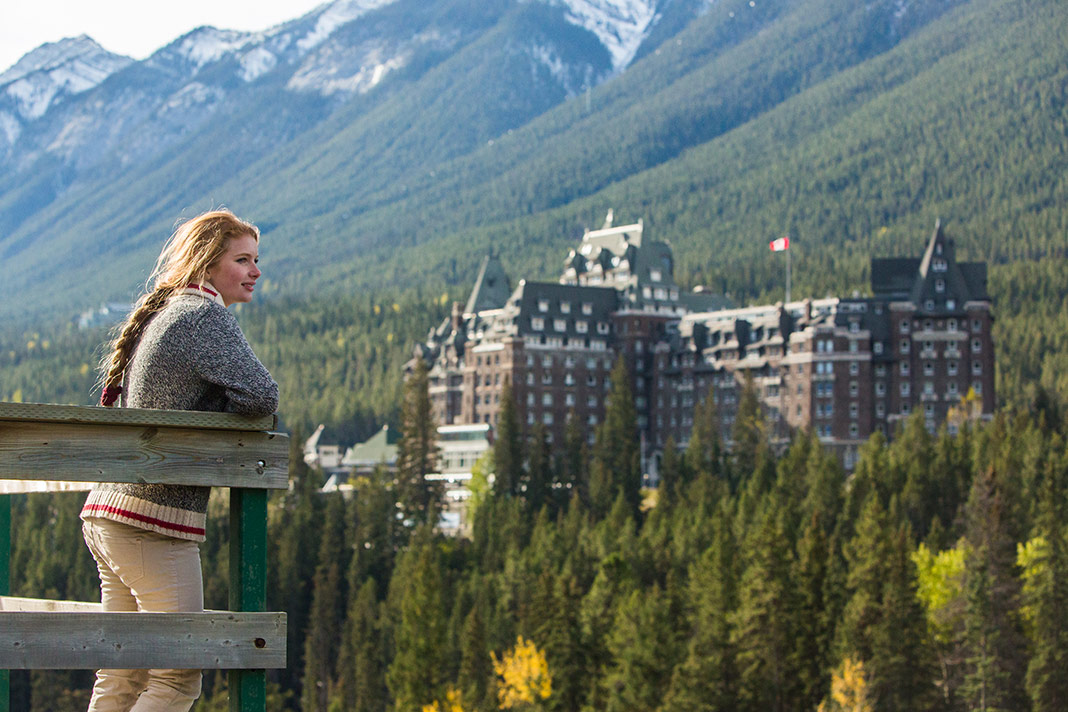
Skoki Lodge
A hotel for true adventurers, Skoki Lodge can only be accessed by hiking or skiing for 11 km. The high-alpine lodge sits at 2,164 meters, somewhere above the Lake Louise ski area. With lodge rooms and log cabins (starting at $200 CAD per night with a two-night minimum), the off-grid property books up months in advance for the summer season, partially thanks to its reputation for great service and filling food.
Banff maps
Banff National Park map
Visitors to Banff National Park will receive a paper map upon payment of their national park entrance fees at the park gates. A visitor guide, with maps, is also available online at the Parks Canada website.
Banff trail map
For most hiking trails, topographic maps are available from the Banff Visitor Centre (224 Banff Ave) and from select retail outlets in town.
Banff town map
Download the Town of Banff’s map, which includes popular trails near town and sites of interest.
A town map is also included in the Parks Canada Visitor Guide and is provided upon entry into the park.
Banff weather
Generally, Banff’s summer season runs from late May until early October, with average highs of up to 22 degrees Celsius. However, being a high-alpine environment means that even during the summer months, the temperatures can be less than balmy—particularly when you’re standing next to a glacier—and in any given month, there’s a chance of snow.
Winters are cold and dry, with the average low being around -15 degrees Celsius. For up-to-date weather forecasts, visit Environment Canada.
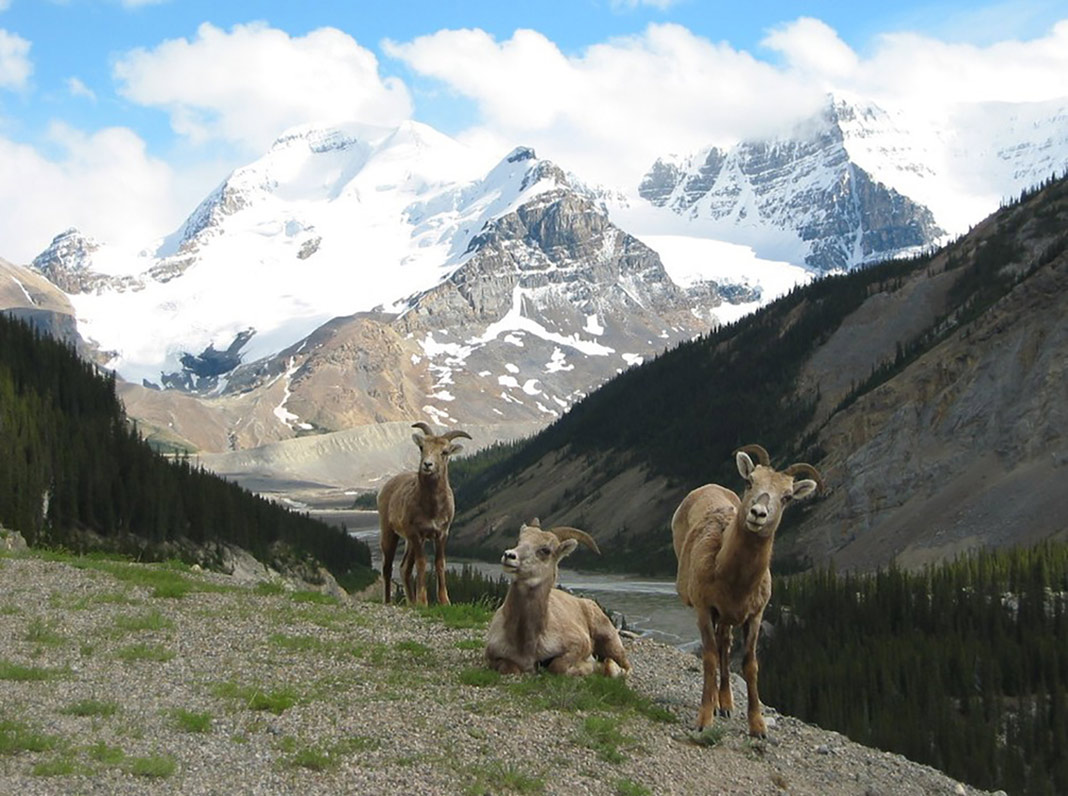
Banff wildlife
Bear sightings near Banff are world renowned, so it pays to be “bear aware” when exploring the area. If you visit the park in the spring, summer or fall months, you have a good chance of seeing bears in Banff, particularly near roadsides where they forage for berries.
While it’s necessary to be particularly conscious of bears, visitors to Banff should be aware of the danger all animals pose—and more importantly, the danger we pose to them. From chipmunks and marmots, to deer and elk, it’s important not to feed the animals, to give them plenty of room, and to do everything we can to ensure they stay wild.
But back to those bears: Carrying bear spray in Banff is a must, particularly if you plan on hiking, camping or paddling in the backcountry. Travel in groups and be sure to make plenty of noise on the trail to warn bears that you’re coming.
A misty mountain Moraine Lake in Banff National Park. | Photo: David Brooke Martin



